Trip Overview
Discover the wildlife and contrasting landscapes of Namibia and Botswana
Namibia and Botswana are two of the top wildlife destinations in Africa and on this itinerary we safari in their most renowned and distinct wildernesses: Etosha National Park and the Okavango Delta. Etosha has an arid landscape scattered with waterholes, where a variety of animals reluctantly congregate for a drink. By contrast, the Okavango is a lush habitat of grassy plains and reed-lined channels carved by wandering elephants. But there is more to this region than wildlife. From the highest dunes in the world at Sossusvlei to the San people’s culture in the Kalahari and the adventure-sport scene at Swakopmund, there is something for everyone on this epic 15-day trip.
At a Glance
- 12 nights in lodges/hotels and two nights of full-service camping
- Travel by purpose-built overland bus, 4×4 vehicle and dugout canoe
- Some long drives
Highlights
- Enjoy safaris in the Okavango Delta and Etosha National Park
- Walk with the San people in the Kalahari Desert
- See the mighty dunes and dead trees of Sossusvlei and Deadvlei
- Explore Brandberg Mountain and see the White Lady rock painting
- Experience the majestic desert scenery of Namib-Naukluft National Park
Is This Trip for You?
This trip is graded Activity Level 2 (Leisurely/Moderate). For more on our trip gradings, visit our Activity Level Guidelines page.
It covers a lot of ground but connects some of the best places in Namibia and Botswana with beautiful landscapes en route. Many of the drives take between four and five hours, with a maximum drive time of approximately eight hours on a combination of paved and gravel roads. On the gravel roads of Namibia, conditions are dependent on how they are maintained at the time and, on occasion, conditions can be poor. This can have an impact on journey times as well as comfort. Drive times to and from Etosha National Park vary depending on the camps we use within the park. Within Etosha National Park, journeys double as game drives. Drive times listed in the itinerary are approximations and vary with road conditions. They also do not include any stops we take along the way.
Transport is in a specially modified safari truck with plenty of legroom and packing space. All vehicles carry a reference library, fridge and/or icebox. Smaller groups may be in a Toyota Hilux/Land Cruiser.
Walks are generally moderate.
There are a few days where we have to get up before sunrise but this allows us to get the most from our days (for example, the game drives in Etosha where we are more likely to see wildlife in the early mornings before it gets too hot).
Accommodation is in lodges and hotels and occasionally in permanent tented camps (which also have beds and private bathrooms) apart from the two nights in the Okavango Delta, which are in our wild campsite, allowing for a different experience of Africa. This is a safari for people who want to see wildlife and get immersed in nature but do it in more comfort.
Please note, due to the limited amount of accommodation within Etosha National Park, it may be necessary to sleep outside the park on some or all of the nights we are there. This will not impact the number of game drives we have within the park.
Adult min age:
16
Min group size:
4
Max group size:
16
Itinerary
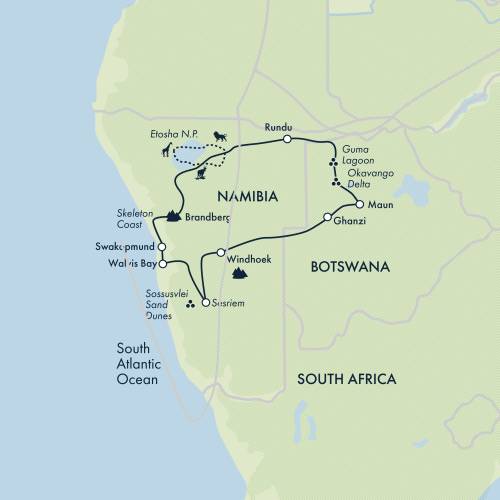
Land Only
- Start City: Windhoek
- End City: Windhoek
Land Only Itinerary
The adventure starts in Windhoek, capital of Namibia. In town, we have the chance to change money and pick up any supplies we may need. We then drive to our lodge and spend the afternoon exploring or relaxing.
Accommodation: Arebbusch Lodge (or similar)
The tour starts in Windhoek. Those on group flights will be picked up at the airport and we will drive into town for an hour or so. In town everyone will have a chance to change money and pick up any supplies they may need. We will then drive to our lodge. The afternoon can be spent exploring or relaxing.
Accommodation: Arebbusch Lodge (or similar)
Leaving Windhoek, we drive east towards Botswana. Our destination today is Ghanzi, a small town in the middle of the Kalahari Desert. Late in the afternoon, we join indigenous San people on a 90-minute walk into the bush to learn first-hand how to survive in this arid environment. In the process, learn more about San culture and the wildness they live in.
Total drive: 330mi (530km), 7hrs 30mins
Accommodation: Ghanzi Trailblazers (or similar)
Today we travel into the Okavango Delta. Following lunch and a welcome briefing, we board mokoros (traditional dugout canoes) and head to our Delta camp (depending on water levels we may drive in a 4×4). Pack light for the next three days, all luggage goes to camp by mokoro. Camp is ready for us on arrival and we meet the local staff who are our hosts for the next few days. The camp is made of dome tents fitted with camp beds, a mess tent and bathrooms that have a bush-shower and toilet. Camping allows us to experience Africa at its fullest, with the sounds of the Delta around us and some of the best views of the Milky Way you are likely to see.
Total drive: 185mi (300km), 4hrs
Accommodation: Okavango Delta wild camp
The Okavango Delta is one the largest inland deltas in the world and unusual because the water never reaches the sea. Instead, the Okavango River empties onto open land, creating a unique and ever-changing wetland wilderness. Year-round, the Delta is home to a vast array of animals including elephants, lions and hippos, though numbers reach their peak during the drier winter months.
We get up early this morning for breakfast and then spend the rest of the day exploring the waterways and islands by mokoro and on foot. This evening, we can enjoy sundowners and, following dinner, relax around the campfire looking back on a day well spent.
Accommodation: Okavango Delta wild camp
After another early start, we enjoy one final exploration of the Delta before returning to our collection point by mokoro. Following lunch, we drive to the town of Maun where we have a free afternoon to relax or enjoy one of the many optional activities available, such as scenic flights or helicopter rides.
Accommodation: Sedia Riverside Hotel (or similar)
We have a relaxed morning before heading to the northern part of the Okavango Delta. Leaving our vehicle behind, we take a 4×4 transfer to our lodge, which is located on the banks of the Delta. This area is a birdwatcher’s haven, there is also the option of an afternoon boat ride.
Total drive: 220mi (350km), 5hrs 30mins
Accommodation: Guma Lagoon Lodge (or similar)
We continue our journey north and cross back into Namibia through the Mohembo border post. From here, we travel in Mahango National Park, which is home to a variety of wildlife, including elephants, which can commonly be seen from the roadside. Our drive along the Caprivi Strip takes us to the small town of Rundu, situated on the Okavango River close to the Angolan border. This town is our home for the evening.
Total drive: 250mi (400km), 6hrs 30mins
Accommodation: Nkwazi Lodge (or similar)
Our destination today is Etosha National Park. We should arrive in time for a late afternoon game drive before heading to our accommodation. We typically stay within the park on some or all of the nights (subject to availability) and some of these are located next to waterholes. These camps also offer optional night drives, which you can book and pay for on arrival.
Total drive: 280mi (450km), 8hrs
Accommodation: Namutoni Lodge (or similar)
In complete contrast to the Okavango Delta, Etosha National Park is a relatively arid wilderness of mixed forest and grassland centred around a large saltpan. It is scattered with waterholes where a great variety of animals congregate to drink, making them fairly easy to find. Zebras, giraffes, cheetahs, elephants and lions are all present, while the park is also home to several black rhinos. Additionally, Etosha is a good place for birds, with plenty of water birds on the lakes and weaverbirds and hornbills in the trees.
Accommodation: Okaukuejo Lodge (or similar)
Leaving Etosha, we stop by the small town of Outjo before continuing our journey towards Brandberg,the highest mountain in Namibia, in Damaraland. The Damaraland area is famous for the desert elephants that roam the Ugab River, while stargazing is normally spectacular from this remote spot.
Total drive: 235mi (380km), 6hrs
Accommodation: Brandberg White Lady Lodge (or similar)
We begin our day with a short drive to Brandberg, where we enjoy a walk through a valley for approximately 1hr 30min. Along the way, we view beautiful, granite formations and a variety of birdlife. The valley takes us to the famous White Lady rock painting which, along with a number of other small paintings and engravings, are thought to have been left by indigenous San people at least 2,000 years ago (please note, if elephants walk into this area then it might be too dangerous to do the walk – in this case we typically go on a game drive looking for elephants). Afterwards, we head towards the Atlantic Ocean and the coastal town of Swakopmund. This small German colonial resort town has quaint cake shops and coffee houses and is known as a centre for adrenaline activities.
Total drive: 185mi (300km), 4hrs 30mins
Accommodation: Prost Hotel (or similar)
Today is a free day to enjoy one of the many optional activities on offer in and around town. On the water, you can go deep-sea fishing; in the desert, you can go sandboarding and quad-biking; and in the sky, you can fly over the Skeleton Coast. Or if none of these appeal, spend the day enjoying fantastic Viennese-style cakes, walk along the beach or nearby dunes, or just watch the world pass in this town that seems strangely out of place in Africa.
Accommodation: Prost Hotel (or similar)
After breakfast, we visit nearby Walvis Bay where we hopefully see flamingos. Our journey then takes us through the Namib-Naukluft National Park – home to one of the driest and oldest deserts on Earth. The park contains spectacular desert scenery and there are photo opportunities along the way.
Total drive: 210mi (340km), 5hrs 30mins
Accommodation: Weltevrede Guestfarm (or similar)
We have an early start so we can see the tallest dunes in the world in the morning light. We also have the opportunity to climb one of the dunes for fantastic views of the area. After, we can either walk to Hiddenvlei or take a transfer (optional extra) to Deadvlei, where ancient acacia trees in the desert form an eerie scene. If we’re lucky, we may see gemsbok or ostriches among the dunes. In the afternoon, we take a walk in Sesriem Canyon before returning to our accommodation. In the evening, we enjoy our final dinner together.
Total drive: 125mi (200km), 3hrs 30mins
Accommodation: Weltevrede Guestfarm (or similar)
We typically have an early start this morning as we have a long drive back to Windhoek where the tour ends. If you’d like to spend a bit longer in Namibia, speak to your sales representative about extending your stay.
Total drive: 210mi (340km), 6hrs
Please note: The group transfer back to Windhoek is scheduled to align with a chosen flight to London, UK; therefore, you should not book flights leaving before then. Please contact your sales representative for the timings of this flight.
Accommodation
Guesthouses, lodges and wild camping
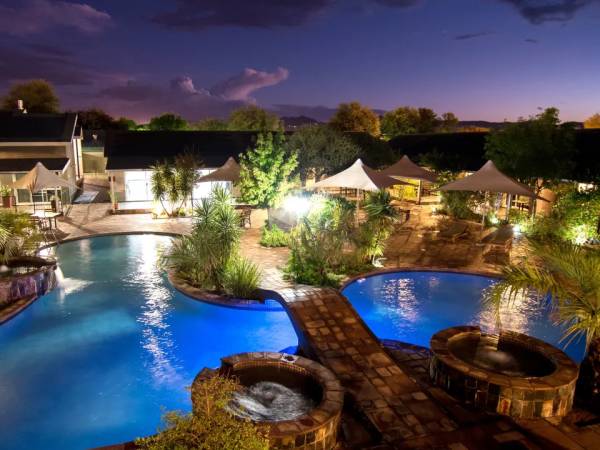
For our time in Namibia and Botswana, we spend 12 nights in lodges/hotels and two nights full-service camping. Occasionally, we stay in permanent tented camps. These are comfortable rooms, in part made of canvas, with private bathrooms and are a quintessential African safari experience. Properties are comfortable, well located for our activities and some have swimming pools. Below are a few of the standouts.
Wild camping in the Okavango Delta
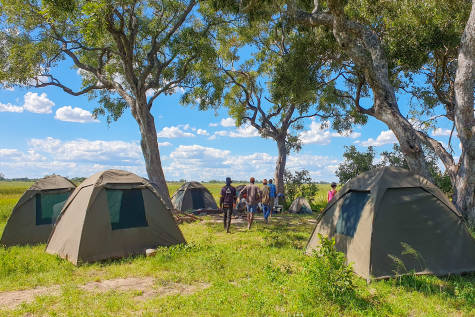
The highlight stay on this trip for many is our two nights of wild camping in the Okavango Delta. Our neighbours, which you’ll likely hear shuffling around at night, include hippos, elephants and lions, while our away-from-it-all location normally allows us to see a night sky illuminated with stars. To make things easier, our camp is set up for us and all equipment is provided. We sleep in spacious, two-person tents fitted with thick foam mattresses and there is a bush shower and toilet, while dinner is taken around our atmospheric campfire.
Brandberg White Lady Lodge
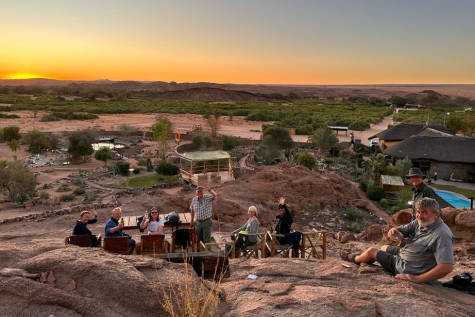
Our Brandberg stay is in the middle of nowhere. From the viewpoint, you will not see another property, just the ruggedly beautiful landscape of Damaraland and possibly some desert elephants in the distance. There’s a dining area, well-stocked bar, lounge, and two swimming pools.
Lodges in Etosha National Park
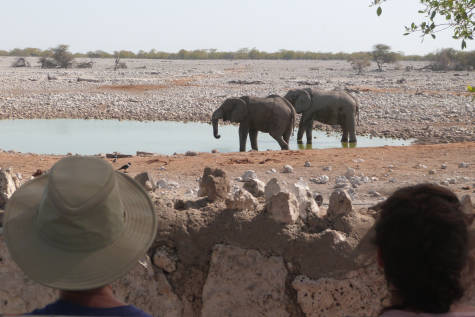
In Etosha, we stay within the national park itself – a huge plus for any animal lover. The resorts we use are either Okaukuejo, Halali or Namutoni. Each location has a restaurant, swimming pool and bar but the highlights are the flood-lit waterholes where wildlife regularly stops to drink and bathe.
Worth knowing
- Wifi is available in several properties but not everywhere, notably not in Sesriem, Etosha or Waterberg.
- When visiting the Delta, we take only what we need for three days (sleeping bags and pillows are provided).
- Due to the limited amount of accommodation within Etosha National Park, it is sometimes necessary to sleep outside the park. However, this is rare. Where we stay will not impact the number of game drives we have within the park.
Single supplement from £ 450
Food & Drink
All breakfasts, four lunches and eight dinners are included.
For meals not included, please allow the equivalent of approximately £12.50/US$15 per meal per person. Some meals are in restaurants or the lodges while others are prepared by the crew. Camp meals are freshly cooked over the campfire. They are wholesome and plentiful, but do not expect cordon bleu cuisine and please note it is not always easy to get fresh meat. However, the standard of food is generally good.
- Breakfast: Cereals, coffee, yoghurt, muesli, fresh fruit or the occasional fried breakfast
- Lunch: Cheese, cold meats, pasta, salads, bread or rolls
- Dinner: Potjie (stew), braai (barbecue) or stir fries
Vegetarians are well catered for on this trip though sometimes options might be more limited.
Transport
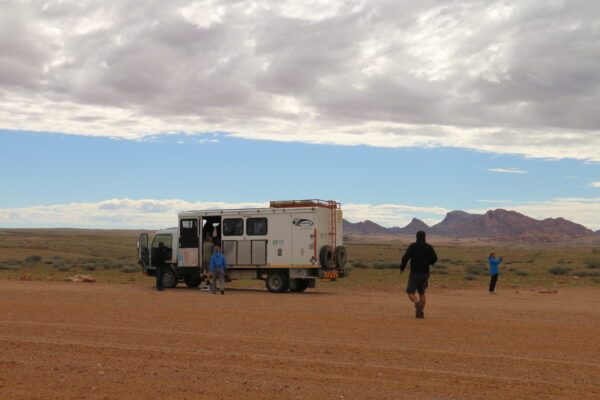
The vehicle normally used for this trip is a specially modified safari truck with up to 16 seats for guests. Seating is forward facing and the windows are large and easy to open. Smaller groups may be in a Toyota Hilux/Land Cruiser. People are expected to move around to permit everyone a chance to have a window seat. All vehicles have a reference library and icebox. Please note, it is not safe to stand when the vehicle is moving, please remain seated until the vehicle stops, even on game drives.
Entering the Okavango Delta is done by mokoro, a traditional dugout canoe that sits low in the water and is poled by one of the expert polers from the local community.
Weather & Seasonality
Namibia
Namibia is in the Southern Hemisphere, so essentially has the opposite seasonality to the UK and North America. June, July and August, while clear and warm during the day, can get cold at night, even reaching freezing point.
Between September and May, it is considerably warmer with October to March being the hottest, getting up to the high 30Cs (around 100F). However, it is always a dry heat and the temperature does drop at night. The wet season is between November and February, but this is not a bad time to go as the desert blooms after rainfall, there is plenty of birdlife to see and it never rains for very long.
Botswana
There is no best time to go for game viewing or conditions in the Delta as the Delta flows year-round despite flood periods. The wettest season is January and February when travel on dirt roads becomes difficult. March to September, although dry and bright, can be cold at night (in June and July it really can be chilly on occasions so bring appropriate gear). October and November are the hottest months, and midday temperatures can be uncomfortable. The rains normally start slowly in late November. December can be wet, but it does not rain for long periods and should definitely not put anyone off travelling as there is always plenty of sunshine.
Joining Instructions
Key information
Start hotel: Arebbusch Lodge, Cnr of Golf & Auas Rd, Olympia, Windhoek
Phone: +264 61 252 255
Recommended arrival time: You can arrive at any time today. There will be a welcome briefing in the evening, but if you miss it the leader will update you separately
Airport: Windhoek Airport (WDH)
Getting to the start hotel
The start hotel is approximately 45 minutes’ drive from the airport. Exodus provides free arrival transfers to the start hotel from the airport for all customers. If you would like further information on joining this trip, please speak to your sales representative.
Catching your return flight
The last night of the trip is spent in the Sesriem and the tour finishes in Windhoek. The group transfer back to Windhoek is scheduled to align with a chosen flight to London, UK; therefore, you should not book flights leaving before then. Please contact your sales representative for the timings of this flight. Free airport departure transfers are only available for return flights departing after the chosen flight route to London – from our Windhoek hotel (if you have booked post tour accommodation) to the airport.
Please note, unless specified otherwise, the transfers will be to the start (or pre-tour) hotel and from the end (or post-tour) hotel and will be on the date on which the tour starts/ends; transfers to other hotels in the same city and/or on different dates may attract an extra charge. Transfers should be booked with your sales representative at least two weeks before the tour starts.
Full joining instructions including local emergency numbers will be sent to you as part of our Final Joining Instructions. If you do not receive these at least a week before departure, or require them earlier please contact our office or your travel agent.
Full joining instructions including local emergency numbers will be sent to you as part of our Final Joining Instructions. If you do not receive these at least a week before departure, or require them earlier please contact our office or your travel agent.
Location start: Windhoek
Location end: Windhoek
What To Take
Essential Equipment
- Torch (flashlight)
- Sun hat and glasses
- Sunscreen
- Insect repellent
- Good walking shoes
- Backpack (big enough to carry essentials into the Delta)
- Swimwear
- Towel
- Clothes for hot and sometimes cold weather (long tops and bottoms to protect from mosquito bites)
- Neutral-coloured clothes for the game walks
Water included
Plastic bottles are a big issue in many countries where recycling isn’t yet widely available; they often end up in landfill or get burnt. Both processes are harmful to the environment and we would like to reduce our impact here. On this trip, the tap water is safe to drink throughout most of Namibia but not Botswana; however, the vehicle has a water tank. This means that safe drinking water will be available throughout; all you need to do is bring a bottle to refill along the way. During the drier months, tap water may not taste as nice. If you prefer the taste of bottled water, it is possible to purchase and refill from 5l bottles throughout the itinerary.
Pack for a Purpose
If you find a spare bit of space while packing please be sure to check with our partner Pack for a Purpose (www.packforapurpose.org) to identify items needed locally by schools and medical clinics. Your tour leader can assist with donating the items.
Optional Equipment
- Binoculars and a camera with a zoom lens (at least 300mm if you want good animal shots)
- Solar charger (as there will be no electricity in the Delta)
- Waterproof bags (to protect valuables on the mokoros)
Practical Information
Passport
Remember to check the expiration date of your passport if travelling internationally. Many countries require your passport to be valid for at least six months after the date of your scheduled return.
Visa
Namibia
Travellers from the UK, US and some EU states normally do not need a visa to enter Namibia. Please note, visa requirements often change and it is your responsibility to obtain any required visas for this trip. Therefore, we recommend that you check with the nearest embassy or consulate of your chosen destination(s), including any countries you may be transiting or transferring through.
Some local governments provide guidance on what visas their citizens need. To help, we’ve gathered a selection of useful links below.
• Australia: www.smartraveller.gov.au/destinations/africa/namibia
• Canada: www.travel.gc.ca/destinations/namibia
• United Kingdom: www.gov.uk/foreign-travel-advice/namibia/entry-requirements
• USA: www.travel.state.gov/content/travel/en/international-travel/International-Travel-Country-Information-Pages/Namibia.html
If you are transiting through South Africa and are a non-UK passport holder you may require a transit visa. Please check before travelling. Please note that if flying via South Africa you will probably have to pass immigration there.
Passports: To enter Namibia, your passport must have an ‘expiry date’ at least 6 months after the date you arrive. It must also have at least one blank page. If you’re travelling to South Africa, you will need an additional 2 blank pages.
Travelling with children: In addition to valid passports, parents travelling with children (under 18) should at all times carry the original or certified copy of the unabridged birth certificate (listing the child’s and both parents’ details). Adults travelling with children where they are not the biological or legal guardians of those children, should be in possession of an affidavit statement from the child’s parents giving consent for their travel. If a child is travelling with only one parent, the other parent should give consent for travel in the form of an affidavit.
Botswana
Travellers from the UK, US and EU normally do not need a visa to enter Botswana. Please note, visa requirements often change and it is your responsibility to obtain any required visas for this trip. Therefore, we recommend that you check with the nearest embassy or consulate of your chosen destination(s), including any countries you may be transiting or transferring through.
Some local governments provide guidance on what visas their citizens need. To help, we’ve gathered a selection of useful links below.
Please note, if you are transiting through South Africa and are a non-UK passport holder you may require a transit visa. Please check before travelling. Please also be aware that children under the age of 18 must provide a full birth certificate (a short one won’t be accepted) as well as a valid passport. If the child is travelling with only one parent or with another adult, the missing parent (or parents) will have to provide an affidavit giving their consent for the child to travel. If flying via South Africa, you may have to pass immigration between flights and the same regulation is needed for entry into South Africa.
Vaccinations and Health
Namibia
There are no mandatory vaccination requirements.
Recommended vaccinations are: Polio, Tetanus, Diphtheria, Typhoid, Hepatitis A.
Malaria prophylaxis is essential and we suggest that you seek advice from your GP or travel health clinic about which malaria tablets to take.
Botswana
Vaccination against Yellow Fever is necessary if you are coming from a country with Yellow Fever, and you must bring a valid certificate of vaccination (Namibia was not on this list at the time of writing – September 2019).
Recommended vaccinations are: Polio, Tetanus, Diphtheria, Typhoid, Hepatitis A.
Malaria prophylaxis is essential and we suggest that you seek advice from your GP or travel health clinic about which malaria tablets to take.
Bilharzia is known to occur in some of the lakes or rivers visited on this itinerary, we therefore advise all to take advice from your guide or leader locally before venturing for a swim.
Local Time
Namibia's time zone: Africa/Windhoek (UTC +02:00)
Botswana's time zone: Africa/Gaborone (UTC +02:00)
Electricity
Namibia's electricity: Plug types D (three round pins) and M (three round pins) – 230V, 50Hz
Botswana's electricity: Plug types D (three round pins) and G (three rectangular pins) – 230V, 50Hz

Money
Namibia's currency: Namibian dollar (NAD)
Botswana's currency: Botswana pula (BWP)
ATM Availability
There are ATMs in the main towns and the airport, but you should not rely on these for all your money. Credit cards are widely accepted, including at most hotels and restaurants.
Extra Expenses & Spending Money
Please allow approximately £12.50/US$15 per person for meals not included
Optional excursions
Swakopmund
- Deadvlei transfer (if not walking to Hiddenvlei on Day 3): 180 Namibian dollars (£9.90/US$12)
- Quad‐biking: 850 Namibian dollars (£48/US$58) for two hours; 600 Namibian dollars (£33/US$40) for one hour
- Fat biking: 500 Namibian dollars (£27.10/US$33) for two hours
- Flight over Sossusvlei and Skeleton Coast: 5,300 Namibian dollars (£295/US$360) for two hours
- Ocean fishing 1,200-1,500 Namibian dollars (£67-£83/US$81-US$101)
- Living desert tour: 1,000 Namibian dollars (£55/US$67) for a half day
- Swakopmund township tour: 750 Namibian dollars (£43/US$52)
- Sandboarding: 600 Namibian dollars (£34/US$41) for lay down; 700 Namibian dollars (£40/US$48) for stand up
Brandberg
- Elephant game drive: 690 Namibian dollars (£30/US$37)
Etosha
- Additional Etosha safari: 750 Namibian dollars (£42/US$51)
Windhoek
- Windhoek township tour: 480 Namibian dollars (£27/US$32), minimum two people, otherwise the price is higher
- Okapuka Ranch: 350 Namibian dollars (£20/US$24) for a game drive and 580 Namibian dollars (£32/US$39) for a one-way transfer to the ranch
- Daan Viljoen Game Reserve: 150 Namibian dollars (£7.50/US$9) for entrance fee for walking trail and 650 Namibian dollars (£36/US$44) for a one-way transfer to reserve
Okavango
- Helicopter ride (25 minutes): 4,400 pula (£255/US$325) per person (minimum three people – prices vary by group size)
- Scenic flight: 4,050 pula (£235/US$300) per person (minimum four people – prices vary by group size)
- Guma Lagoon boat ride: 340 pula (£20/US$25) per person
These prices are subject to change.
Tipping
If you feel your leader and support team have performed well, you may want to show your appreciation of their services. The sum you choose to give is entirely personal, but as a guide we suggest the equivalent of around £1.25-£2.50/US$1.50-US$3 per person per day. For the two nights in the Okavango Delta, we recommend a tip of approximately 250 pula (£16.50/US$20) per person for our polers. For other staff such as porters, we recommend that you budget for a further £4.10-£6.60/US$5-US$8.
People, Places & Planet
We work hard to create trips that have a positive impact on the people and places we visit and look after the planet we explore. Learn more about our sustainable travel ethos and practice here and find out about the work of the Exodus Travels Foundation here.
Some sustainable travel highlights of this trip include:
People
How this trip helps improve life for local communities.
- Local guides keep you well informed about local traditions and cultural-social sensitivities.
- This trip brings income and opportunity to the destination community through the inclusion of locally owned hotels, restaurants and other enterprises, and by championing locally produced food wherever possible.
- Read more about our other initiatives here.
Places
How this trip helps protect and conserve local landscapes and nature.
- By travelling in a small group, we ‘tread lightly’ to minimise our impact on local resources and the environment.
- We work with our partners on the ground to proactively reduce waste; this includes eliminating all single-use plastic water bottles by providing refills for reusable bottles.
- Energy-saving bulbs and water-conservation signs utilised in the lodges are a great way to reduce environmental impact.
- On our wildlife safaris and game drives, 25 percent of all park entrance fees are reinvested into essential infrastructure and services related to tourism in the parks of Namibia. This is done through the Game Products Trust Fund by the MET (Ministry of Environmental and Tourism). In addition, by running game drives in Etosha National Park, we are contributing to local community initiatives and helping to fund the protection of the wide range of species that live there.
- Our trips adhere to ABTA’s industry-leading animal welfare guidelines to ensure the best possible practices regarding working animals and wildlife viewing. Our animal welfare policy can be found here.
- We rewild 1,075sqft (100sqm) per passenger to compensate for all trip and flight emissions.
- Read about our commitment to nature protection and restoration here, including our rewilding commitment for every customer who travels with us.
Planet
How we seek to keep the carbon footprint of this trip low.
- Accommodation and restaurants in the itinerary use locally sourced food which has not been transported long distances.
- Read about our climate action here, including our carbon reduction and compensation commitments.
Tips for sustainable travel on this trip
- Leave no trace: We do all we can to ensure we leave no rubbish in the wild and beautiful places we visit; we ask that you do the same. If there are no recycling facilities in-country, consider bringing recyclable materials home with you.
- Plastic waste reduction: Please bring a reusable water bottle on this trip, also consider avoiding single-use hotel toiletries, which generate a large amount of plastic waste.
Important Information
Optional activities and excursions
If you would like to join an optional activity or excursion outside those listed in the itinerary, your leader may be able to assist with selecting a provider. However, Exodus has not assessed the safety standards of activities or excursions that are not listed in the Trip Notes. All optional activities or excursions are undertaken at your own risk.
Water safety
This trip includes time by a lake, river or sea, where there may be opportunities to swim. You should always seek local advice before deciding whether to swim. Open-water or wild swim spots should be treated with extreme caution. Information on how to keep yourself safe while swimming is shown here.
Important Information
Your safe participation
When booking this trip, you should be confident in your ability to participate in all activities described in these Trip Notes. If you have any doubt about your suitability, please call the Exodus office and ask to speak to one of the experts on this itinerary.
Although our leaders are well trained to deal with different capabilities, if they have any concerns about someone’s ability to safely take part in an activity, or their impact on other people’s enjoyment, we authorise them to take necessary action which, in some circumstances, may involve asking someone to miss that activity.
By booking this trip you agree to our Booking Conditions which clearly state that our leaders have the authority to do this. In these rare instances we will ensure anyone sitting out is safely provided for and offered alternative options where possible. Refunds will not be provided for activities missed and customers may be liable for additional costs incurred.
How to Book
- Check availability: Go online to check availability, or contact us by phone or email.
- Secure your place: You can provisionally hold a place on this trip, usually for between three and seven days.
- Complete your booking and payment
When you’re ready to book, go to our website for online bookings, book over the phone or you can complete a booking form (available online or on request by calling us). We accept all major credit and debit cards, or you can pay be cheque.
After booking
You will receive your booking confirmation letter and invoice, which includes extra information and guidance about your travel arrangements.
Full joining instructions, including local emergency numbers and details of how to reach the start point, will be sent to you approximately two to three weeks prior to departure. If you do not receive these at least a week before departure, or require them earlier, please contact our office or your travel agent.
Trip Note validity
These Trip Notes are valid from the “Current as” date on page one. They will occasionally be updated after booking and before departure; if there are any updates that significantly impact the inclusions or itinerary, customers will be written to separately. They will also receive a link to the most up-to-date Trip Notes with their Final Joining Instructions before travelling.
The information in these Trip Notes is given in good faith. Where differences exist between the Trip Notes and our current brochure or website, the Trip Notes supersede the brochure and website. All holidays can be subject to unexpected changes; to enjoy them you should be prepared to be flexible where necessary. Occasionally, it may not be possible to follow the itinerary as planned. This may be for a variety of reasons – climatic, political, physical or other. In these circumstances we will make the best-possible alternative arrangements that maintain the integrity of the original itinerary.
Licensing
Exodus is fully licensed and bonded as a tour operator. We hold Air Traffic Organisers Licence (ATOL) number 2582, issued and bonded with the Civil Aviation Authority (CAA). We are also bonded to the International Air Transport Association (IATA) and we are members of the Federation of Tour Operators (FTO) and ABTA – The Travel Association. This means you can book your Exodus holiday with confidence, as all money paid to us for your trip is fully protected.







